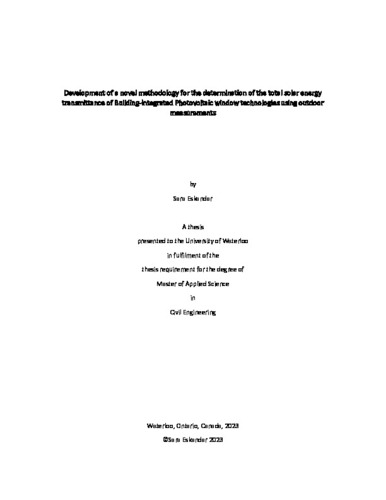| dc.description.abstract | The urgent need to combat global warming and transition towards sustainable energy sources has focused attention on the building sector, a major contributor to energy consumption and greenhouse gas emissions. To achieve net-zero energy building performance, a comprehensive approach is essential, involving energy conservation measures, enhanced building systems efficiency, and integrating on-site renewable energy generation. Within this context, the integration of photovoltaic window technologies become essential for the generation of renewable electricity and reduction of solar heat gains which impacts building heating, cooling, and electric lighting loads as well as visual and thermal comfort.
The aim of this thesis is to introduce the theoretical background of a novel experimental methodology for the determination of total solar energy transmittance (TSET) of building-integrated photovoltaic (BIPV) windows using outdoor measurements. Existing studies and standards dictate the use of indoor test facilities consisting primarily of a hot box calorimeter where the window is mounted and characterized under a steady state solar simulator. The calorimetric (thermal) methods require steady state conditions that have been proven challenging to achieve for windows that incorporate advanced shading devices or photovoltaic cells, potentially resulting to significant measurement errors of the TSET. Also, these studies rarely characterize the angular dependency of TSET.
To overcome these challenges, a novel experimental methodology is proposed to measure TSET using optical measurements under outdoor conditions. The experimental setup uses pyranometers (for solar transmittance measurements), pyrheliometer (for direct incident measurements), several Resistance Temperature Detector (RTD) sensors and infrared cameras (for surface temperature measurements), allowing the determination of TSET (and its angular dependency) based on a series of instantaneous outdoor measurements under sunny conditions that could result to reliable and repeatable TSET values. For the case of BIPV windows, a load at maximum power point (MPP) is connected to the window, allowing the maximum fraction of the absorbed solar energy to be converted into electricity. Finally, a new approach is proposed for the conversion of measured TSET to TSET under standard conditions, using a reference window of known TSET.
The unique aspects of the proposed TSET methodology are: i) the use of optical measurements ii) performed under transient outdoor test conditions. Current standard TSET calorimetric tests use thermal measurements that require long window conditioning under steady state conditions. The new methodology is also able to perform TSET measurements under a range of solar angle of incidence (i.e., 0 to 60 degrees), including normal TSET. The limitation of the proposed methodology is that it is not applicable to products with angular selective properties (e.g., microshade film). While it is developed for BIPV windows, and can be applied for TSET determination of coated, reflective, and electrochromic windows, under outdoor test conditions.
In summary, a novel experimental methodology is proposed for the determination of the total solar energy transmittance of Building-Integrated Photovoltaic windows using outdoor measurements. The proposed methodology aims to provide a framework to quick, accurate, consistent, and repeatable approach to TSET testing that can potentially be standardized for BIPV windows and other advanced window technologies. The proposed methodology intends to support the advancement of sustainable building practices, enhance energy efficiency, and foster the integration of renewable energy technologies into building design and construction, paving the way for a more sustainable built environment. | en |

